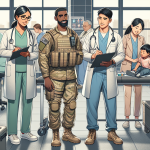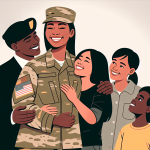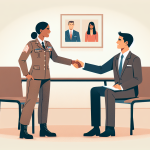From the Continental Army fighting for independence to today’s technologically advanced force operating worldwide, the U.S. Army has changed a lot over the last 250 years.
The Revolutionary Genesis: Birth of the Continental Army (1775-1783)
U.S. Army history begins on June 14, 1775, when the Second Continental Congress established the Continental Army to unite colonial militias for the Revolutionary War. George Washington’s appointment as Commander-in-Chief marked the beginning of a professional military tradition that would define American defense strategy for centuries.
Early Challenges and Victories
The Continental Army faced extraordinary obstacles during the Revolutionary War:
- Limited resources: Chronic shortages of weapons, ammunition, food, and clothing
- Irregular training: Soldiers were primarily civilian volunteers with minimal military experience
- Seasonal service: Many enlistments expired during winter months, creating constant personnel turnover
- Financial constraints: Continental Congress struggled to fund operations consistently
The victory at Yorktown in 1781, achieved through coordination with French naval forces, secured American independence and proved George Washington’s vision of a disciplined regular army.
Post-Revolutionary Reorganization and Early Republic (1783-1812)
Following the Treaty of Paris in 1783, American suspicion of standing armies led to rapid demobilization of the Continental Army.
Legislative Foundations
The Uniform Militia Act of 1792 mandated enrollment of all able-bodied white males aged 18-45 in state militias.
The Calling Forth Act of 1792 granted presidential authority to mobilize state militias, powers first exercised during the Whiskey Rebellion (1794).
The Insurrection Act of 1807 expanded presidential control over federal forces, establishing precedents for federal military intervention that remain relevant today.
The War of 1812: Lessons in Military Preparedness
The War of 1812 exposed critical weaknesses in America’s decentralized military system. Over-reliance on state militias, many reluctant to serve outside their home regions, contributed to failed campaigns including the unsuccessful invasion of Canada and the burning of Washington, D.C.
Westward Expansion and the Indian Wars (1812-1890)
Throughout the 19th century, the U.S. Army’s primary mission involved westward expansion and conflicts with Native American tribes.
Characteristics of Frontier Warfare
- Dispersed operations: Small garrisons scattered across vast territories
- Guerrilla tactics: Adaptation to unconventional warfare techniques
- Logistical challenges: Extended supply lines across difficult terrain
- Cultural conflicts: Managing relationships between settlers and indigenous peoples
The Civil War: Federal Military Power Emerges (1861-1865)
The American Civil War represents the most significant transformation in U.S. military history. Beginning with a tiny regular army focused on frontier defense, the conflict ultimately mobilized millions of Americans through unprecedented federal conscription.
The Enrollment Act of 1863
This landmark legislation authorized direct federal conscription, marking a shift toward centralized military control and established precedents for mass mobilization in the future.
Key Civil War Developments
Scale of Mobilization: Over 2.8 million men served in Union forces.
Technological Innovation: Introduction of rifled firearms, telegraph communications, railroad transportation, and industrial production methods.
Minority Participation: Approximately 200,000 African Americans served in United States Colored Troops units, despite facing severe discrimination.
Logistics Revolution: Quartermaster General Montgomery C. Meigs developed sophisticated supply systems that sustained massive armies across continental distances.
World War I: The National Army Experiment (1917-1918)
World War I transformed the U.S. Army from a small professional force into a mass conscript army exceeding six million personnel. The Selective Service Act of 1917 established systematic conscription, mobilizing two million soldiers for European deployment.
American Expeditionary Forces Achievements
General John J. Pershing’s American Expeditionary Forces played crucial roles in:
- Meuse-Argonne Offensive: The largest American military operation to date
- Independent Operations: Maintaining American command autonomy within Allied structures
- Combined Arms Integration: Coordinating infantry, artillery, aviation, and tank operations
World War II: Total Mobilization and Global Operations (1941-1945)
World War II required unprecedented mobilization, creating the “Army of the United States” that combined regular, National Guard, and conscript forces into a unified eight-million-person organization.
Major Theater Operations
European Theater: North African campaign, Italian operations, D-Day invasion, and liberation of Western Europe.
Pacific Theater: Island-hopping campaigns, amphibious operations, and air-ground coordination.
Home Front: Industrial production, training facilities, and logistics networks.
Cold War Standing Army (1945-1991)
The Cold War fundamentally altered U.S. military posture, transitioning from temporary wartime mobilization to permanent global commitments. Large standing forces in Europe and Asia deterred Soviet expansion while maintaining technological superiority.
Korean War Impact
The Korean War (1950-1953) validated concepts of limited warfare and international coalition operations, establishing patterns for Cold War military interventions.
Vietnam Era Challenges
The Vietnam War (1965-1975) generated unprecedented domestic opposition, leading to:
- End of conscription: Transition to all-volunteer force by 1973
- Doctrinal revolution: Development of “Active Defense” and “AirLand Battle” concepts
- Professional reforms: Enhanced training, education, and personnel policies
Modern Era: All-Volunteer Force and Global Responsibilities (1973-Present)
The transition to an all-volunteer force fundamentally changed army composition, emphasizing professional development, technological integration, and operational flexibility.
Post-Cold War Adaptations
Following Soviet collapse, the army adapted to:
- Peacekeeping operations: Somalia, Bosnia, Kosovo interventions
- Force modernization: Digital battlefield systems and precision weapons
- Reduced personnel: Right-sizing for post-Cold War threats
Global War on Terror Era
The September 11, 2001 attacks initiated combat operations in Afghanistan and Iraq, testing army adaptability in:
- Counterinsurgency operations: Urban warfare and population-centric strategies
- Equipment innovation: IED-resistant vehicles and advanced communications
- Total Force integration: Seamless blending of active, Guard, and Reserve components
Contemporary Challenges and Future Evolution
Today’s U.S. Army confronts a complex security environment featuring:
- Near-peer competition: Renewed focus on conventional warfare capabilities
- Asymmetric threats: Continued counterterrorism and irregular warfare requirements
- Technological integration: Artificial intelligence, cyber warfare, and autonomous systems
- Global presence: Maintaining alliance commitments while addressing emerging threats
Celebrating the Army’s Birthday
How can you celebrate and support the army this year?
Major National Events:
- National Mall Festival
- Grand Military Parade
- National Museum of the U.S. Army Events
Educational and Cultural Participation
- Museum Visits: The National Museum of the United States Army and other military museums offer special exhibits, educational programs, and interactive displays.
- Historical Research: Many communities have rich connections to Army history through local veterans, historical units, or significant events.
- School and Community Programs: Organize presentations by local veterans, hosting educational events, or arranging visits to military museums.
Community-Level Celebrations
- Traditional Ceremonies: The time-honored cake-cutting ceremony, typically involving the oldest and youngest community members or veterans, symbolizes the continuity of military service across generations.
- Veteran Recognition Events: Inviting local Army veterans to share their experiences at schools, community centers, or civic organizations helps bridge the gap between military and civilian communities.
- Patriotic Displays: Simple gestures like displaying American flags, organizing neighborhood events, or hosting military appreciation gatherings demonstrate community support and pride.
Direct Support and Appreciation
- Personal Interactions: A simple “thank you for your service” to someone in uniform, though brief, can have a meaningful impact.
- Volunteer Opportunities: Volunteering time and skills provides direct, practical support to those who serve.
- Charitable Contributions: Reputable military charities and support organizations offer effective channels for financial contributions that directly benefit soldiers, veterans, and their families.
Check us out at Benefits.com and take our quiz so we can get started helping you on your path to receiving benefits.
 Benefits.com Advisors
Benefits.com Advisors
With expertise spanning local, state, and federal benefit programs, our team is dedicated to guiding individuals towards the perfect program tailored to their unique circumstances.
Rise to the top with Peak Benefits!
Join our Peak Benefits Newsletter for the latest news, resources, and offers on all things government benefits.




















